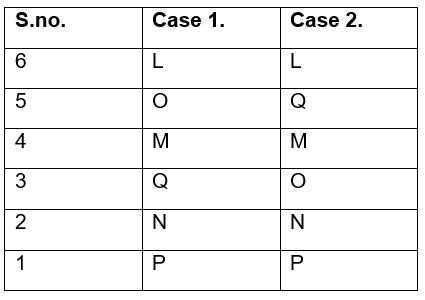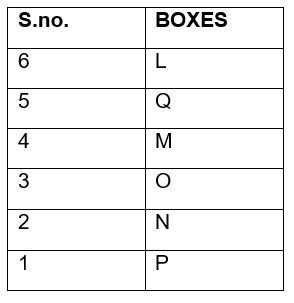Question
Six boxes, L, M, N, O, P and Q are one above the other,
such that the box which is at the bottom is numbered as 1, the box above it as 2 and so on. How many boxes are below Q? Statement I: There are three boxes between L and N. M is two boxes below L. O is above P. O is not the topmost box. Q is neither the topmost box nor the bottommost box. Statement II: P is two boxes below O. There are two boxes between L and O. L is above P. N is two boxes below M. The question given below consists of two statements I and II given below it. You have to decide whether the data provided in the statements are sufficient to answer the question. Read all the statements and give answer.Solution
From statement I, there are three boxes between L and N. M is two boxes below L. O is above P. O is not the topmost box. Q is neither the topmost box nor the bottommost box.  So, either two or four boxes are below Q. From statement II, P is two boxes below O. There are two boxes between L and O. L is above P. N is two boxes below M.
So, either two or four boxes are below Q. From statement II, P is two boxes below O. There are two boxes between L and O. L is above P. N is two boxes below M.  Four boxes are below Q. So, data in statement I alone is not sufficient to answer the question and data in statement II alone is sufficient to answer the question.
Four boxes are below Q. So, data in statement I alone is not sufficient to answer the question and data in statement II alone is sufficient to answer the question.
Anu is four times as good as Binni in completing a task. Together they finish the same task in 7 hours. In how many hours will Anu alone complete the task?
Hema takes a total of 9 hours 55 min to walk a certain distance and then cycling back to the same place from where she had started. She could walk both ...
A contractor assigned a job to three persons A, B and C. ‘A’ which is 25% less efficient than ‘B’ can complete 20% of a work in 8 days. ‘C’ ...
A and B alone can complete a work in 30 and 60 days, respectively. 50% of the work is completed by C in 6x days, and the remaining work is completed by ...
The total age of 'R' and 'D' eight years ago was thirty-six. Four years separate 'R' and 'D' in age. Determine the sum of total age (in years) between '...
What is the angle traced by the hour hand in 23 minutes?
A mobile plan costs Rs.32 for 6 minutes. What is the approximate cost, rupees, for 4 minutes?
A and B can complete a work in 40 and 60 days respectively. They started a work which is to be completed in 20 days. But it was found that they are lagg...
P, Q and R can complete a work in 10 days. 20 days and 30 days, respectively, working alone. How soon can the work be completed if P is assisted by Q an...
A flight has to travel between 2 cities A and B, 2000 km apart. The flight was slowed down due to bad weather. Its average speed for the trip reduced by...
Relevant for Exams:



